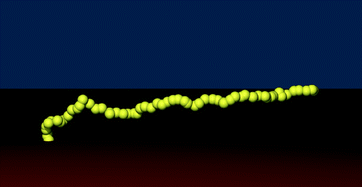Relaxation of an initially-stretched, tethered polymer under shear flow: a Brownian dynamics simulation†
Abstract
The relaxation behaviour of an initially-stretched, tethered flexible polymer chain is studied using the bead–spring model and the Brownian dynamics simulation method. Simulations are performed with and without the inclusion of hydrodynamic interactions. Relaxation is studied in the presence of a shear flow field, characterised by Weissenberg numbers in the range 0 ⩽ Wi ⩽ 55. The presence of a substrate is observed to slow the relaxation of the polymer chain markedly. When shear flow is applied two types of relaxation behaviour are observed, for timescales which are short compared with the longest relaxation time of the chain. For Wi smaller than a critical value, the behaviour is dominated by the entropic collapse of the chain, accompanied by a degree of rotation in the flow. However, above the critical value of Wi, the polymer chain behaves as an almost rigid rod, initially relaxing slightly, and then stretching as it rotates in the flow. The chain attains a maximum value of extension after which an approximately linear relaxation is observed. At long timescales a steady-state extension is reached which varies with the value of Wi. The inclusion of hydrodynamic interactions does not qualitatively affect the observed behaviour. However, it is found that hydrodynamic interactions accelerate the chain relaxation in the absence of flow, while leading to a marked slowing of chain relaxation when shear flows are applied.

- This article is part of the themed collection: Modelling of Soft Matter

 Please wait while we load your content...
Please wait while we load your content...